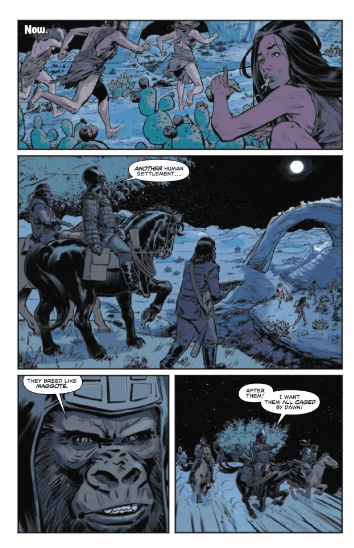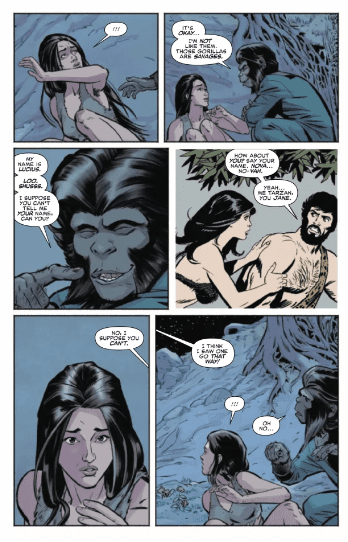Comics often come with a past. Even new “number ones,” featuring new characters, are often laden with the baggage of the creators, artists, and even the publishers working on them. One has a certain expectation from a comic written by someone like Frank Miller, or published by Image Comics. Add to that the complicated narrative and publication history of a franchise like Planet of the Apes, and you know that nothing is going to be straight forward.
With that said, the new Beware the Planet of the Apes from Marvel Comics — by writer Marc Guggenheim and artist Alvaro Lopez, with colors by Alex Guimaraes and letters by Joe Caramagna — manages to avoid a lot of that history. In fact, with the exception of the original movie, you don’t really need to know anything about the franchise, which is no mean feat considering the 55 years of media the franchise has produced. If you want to know how this new comic fits into established (and non-established) canon: it’s set just before Taylor crashes back to Earth in the first movie. Everything else is irrelevant, probably.

Credit: Marvel Comics
The opening two pages are beautiful replications of Marvel’s original Apes comics, and they establish the style and presentation of the 50-year-old stories. It’s a clever trick to remind readers that Apes comics started their life at Marvel. (Well, if you ignore all of those other adaptations that came first, but no one remembers them and it was Marvel that made the Apes comics huge. They published superb adaptations of the original movies as well as ongoing original stories that were as outrageous as the cinematic versions.)
After a little scene setting, the comic begins its difficult task of re-introducing the characters and making them relevant. Guggenheim does this primarily by building on the idiosyncrasies of the actors playing the parts in the movie. These are Kim Hunter, Roddy McDowall, and Linda Harrison, all playing their famous roles, not modern reinterpretations of them. Fans of the movie will hear the actors’ voices oozing from the page: Cornelius’ gentle tones, Zira’s curt quips, and the authoritative abruptness of Doctor Zaius. Guggenheim’s grasp of the characters is perfect and, coupled with the visual renderings, it is easy to sink into this movie prequel and lose yourself in a strange world created in the 1960s. The colouring by Guimaraes captures the palette of the movie, making it feel like a part of the franchise, much more so than Marvel’s other recent foray into the Planet of the Apes.
Lopez draws magnificently detailed images which extract every nuance of the characters and settings. There is a strong sense of location in this comic, with the scenes creating a specific atmosphere—partially of wonder, but also of the impending doom that hangs over the narrative. Everyone knows what is coming; if you’ve picked up this comic, then you’ve probably seen the movies. Instead of shying away from this, the narrative actively embraces it, using flashes of the future. Brief panel sequences act as flash forwards, emphasising a moment in the current narrative while placing it in a larger story. An added touch to this is that they use panels from the original adaptation written by Doug Moench and drawn by George Tuska, yet again reminding readers of the heritage without breaking the narrative flow. When Lucius sounds out his name for the as yet unnamed Nova, there is an out of sequence flash of Taylor sounding out Nova’s name in the same manner. A little treat for fans but also an intriguing moment of comic book storytelling.

Credit: Marvel Comics
When approaching any franchise with this kind of pedigree, you have to don two separate hats: the Fan Hat and the Critic Hat. Something of this nature could be instantly recommendable simply because it’s a new Apes comic set in the original timeline, but that does not mean that it is automatically a great, or even good comic. To make it truly worthwhile as a must have comic, it must be more than the sum of its parts.
With a Fan Hat on, this is undoubtedly an easy recommendation. Do you collect Apes-related comics? Have you read the vast array of tie-in media from the BOOM! Studios comic series to Titan Books’ movie continuations? Have you seen the original movie more than once? If you would answer “yes” to any or all of these questions, then buy this comic. It is a faithful and enjoyable recreation of the original movie aesthetic with some of the early themes of the film series woven into the emerging storyline. Oppressive hierarchical councils and brutish policing spur the heroes to rebel and venture out into the harsh unknown to learn more about the world and themselves. Innocence is contrasted with stark inbred hatred, and the old ways of thinking clash with the younger, more curious minds.
And you may have noticed how the Fan Hat has already started to slip, exposing the Critic hat beneath. This is because there is something inherently fascinating about Planet of the Apes and it is difficult to produce any content that doesn’t have a deeper meaning. On the surface it makes great, enjoyable, science fiction, but because the original film built so much social commentary into its aesthetic, and the narrative was fueled by political undertones, it is almost impossible to escape from that without dispensing with what makes Planet of the Apes what it is.
Doctor Zaius represents the closed-minded religious figure and the hypocritical council member, using well-practiced rhetoric to hide his own fears. The charming relationship between Zira and Cornelius is a metaphor for the struggles within the scientific world—a battle between putting the good of the nation before scientific truth. And then there is the inherent racism that comes from the different aspects of Ape society: the chimpanzee, the orangutan, and the gorilla. The remake movie franchise has lost this aspect, but with the original series, it’s almost impossible to escape. It has to be addressed, and there are moments in Beware where you can see the creators acknowledging the issue.
Alongside the narrative and the wonderful rendering of the characters and locations, there is some amazing comic book design. The layouts change to suit the scene, switching from multiple rows and columns for interior conversations to letterbox panels for panoramic views. The slight difference in art-style between the present of Beware and the future flashes make those moments stick in the reader’s mind and emphasize the connection between present and future. These moments draw attention to the unknown consequences of characters actions and the art style highlights this in an effective way that doesn’t break the reading flow.
There are also some wonderful panels that create so much depth of character. Similar images that are repeated at different points to compare the relationships between the characters. For example, at one point Doctor Zaius denies a request made by Zira and the final panel of the page loses the background, it simply shows Cornelius, Zira, and the firmly closed door. The image unites the two apes as they are both shut out by Zaius and left in this empty, hopeless space. On the next page, there is a moment where Zira shuts Cornelius out in a similar sequence with the door slamming behind her as she leaves, except the background is still present. Cornelius isn’t left in a cold, empty place. This panel may seem the same as the previous one, but it doesn’t have the same hopelessness as the pure white background, and therefore doesn’t feel as serious. These little moments of brilliance elevate this comic from simple entertainment to engrossing Comics with a capital C, allowing the reader to pick apart what they are reading to find hidden depths.
This comic looks and feels like Planet of the Apes. It’s lazy Sunday afternoon viewing. It’s late at night, can’t sleep, indulgence. It’s holding a mirror to the world and asking “is this what you expected?” It’s everything that you could want from the franchise which, if I’m being honest, is a surprise from current Marvel. Their last Apes comic lacked grace and subtlety. It seemed to be an excuse to draw apes on a rampage, whereas Beware is the opposite. It is a thoughtful, beautifully drawn comic, with continuity indulgences that have relevance to the narrative. It is charming, probing, and intriguing. And all of that is down to the creators, clearly loving the franchise and wanting to tell the best story that they can.

